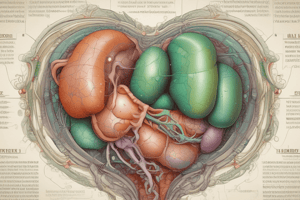Podcast
Questions and Answers
The small intestine connects to the liver, gallbladder, and pancreas through ducts.
The small intestine connects to the liver, gallbladder, and pancreas through ducts.
False (B)
Bile is a basic liquid produced by the liver.
Bile is a basic liquid produced by the liver.
False (B)
The gallbladder plays a crucial role in storing and concentrating bile.
The gallbladder plays a crucial role in storing and concentrating bile.
True (A)
Bile is responsible for the digestion of protein, carbohydrates, and fats.
Bile is responsible for the digestion of protein, carbohydrates, and fats.
The liver produces the enzymes to break down fat.
The liver produces the enzymes to break down fat.
The gallbladder concentrates bile from 600-800 ml to 40-70 ml per day.
The gallbladder concentrates bile from 600-800 ml to 40-70 ml per day.
The gallbladder produces bile independently of the liver.
The gallbladder produces bile independently of the liver.
The gallbladder has a capacity to store approximately 200 ml of bile at one time.
The gallbladder has a capacity to store approximately 200 ml of bile at one time.
Bile secretion by the liver amounts to roughly 600-800 ml each day.
Bile secretion by the liver amounts to roughly 600-800 ml each day.
The main function of the gallbladder is to collect and dilute bile.
The main function of the gallbladder is to collect and dilute bile.
Flashcards
Gallbladder
Gallbladder
A small sac-like organ that stores bile produced by the liver.
Liver
Liver
A large organ that produces bile, a fluid that helps digest fats.
Small Intestine
Small Intestine
The first part of the small intestine where bile from the gallbladder mixes with food for digestion.
Bile
Bile
Signup and view all the flashcards
Digestion
Digestion
Signup and view all the flashcards
What is the gallbladder?
What is the gallbladder?
Signup and view all the flashcards
What does the gallbladder do with bile?
What does the gallbladder do with bile?
Signup and view all the flashcards
How does the gallbladder affect the volume of bile?
How does the gallbladder affect the volume of bile?
Signup and view all the flashcards
Where does the gallbladder release bile?
Where does the gallbladder release bile?
Signup and view all the flashcards
How much bile does the gallbladder hold?
How much bile does the gallbladder hold?
Signup and view all the flashcards
Study Notes
Gallbladder Diseases
- The gallbladder is a small, muscular sac located beneath the liver, in the upper right abdomen.
- It connects to the liver via a short tube, which branches from a larger duct leading to the duodenum (the first part of the small intestine).
- The liver produces bile, a greenish-golden, bitter liquid crucial for digesting fats, cholesterol, and fat-soluble vitamins.
- The gallbladder stores bile, concentrating it from approximately 600-800ml to 40-70ml per day.
- Bile is composed of bile acids, pigments, water, cholesterol, and lecithin (including bilirubin, a breakdown product of red blood cells).
- When a person eats, the lining of the intestine releases the hormone cholecystokinin, signaling the gallbladder to release bile into the duodenum to aid digestion.
Acute Cholecystitis
- Acute cholecystitis is an inflammation of the gallbladder.
- Causes include gallstones blocking the cystic duct (the duct connecting the gallbladder to the common bile duct), or bacterial infection (like Salmonella).
- Symptoms include severe, sharp pain in the upper right abdomen that may radiate to the right shoulder, fever, nausea, vomiting, and indigestion.
- Jaundice (yellowing of the skin and eyes) can be observed in 15% of patients.
- Difficulty taking a deep breath on the right side, while the doctor exerts pressure on the area, without also feeling pain on the left side above the abdomen.
- Other conditions (like peptic ulcers, hepatitis, pancreatitis, kidney stones, and renal colic) can cause similar symptoms, differentiating them can be crucial for diagnosis.
Factors causing acute Cholecystitis
- Diabetes
- Pregnancy
- Rapid weight gain or loss
- Undergoing surgery
- Heart disease
- AIDS
Chronic Cholecystitis
- Chronic cholecystitis is a long-lasting inflammation of the gallbladder.
- Symptoms often include a feeling of fullness and bloating, especially after eating fatty foods, as well as digestive discomfort, and stomach acidity.
Gallstones (Cholelithiasis)
- Gallstones are solid deposits formed within the gallbladder from components of bile.
- They can be cholesterol-based or bile-salt based.
- Cholesterol stones are more common among women due to the impact of estrogen on blood cholesterol levels.
- The conditions contributing to the formation of gallstones include lack of water consumption, rapid changes in weight, and contractive drugs, diabetes, or fasting for prolonged periods.
- There can be an infection related to bacteria such as E. coli.
Gallstones Symptoms
- Some symptoms are similar to acute cholecystitis (for example, pain in the upper right abdomen, nausea, and vomiting).
- In some cases, there are no noticeable symptoms.
- Jaundice and steatorrhea (fatty stools) can sometimes arise.
Treatment
- Dietary modification is often a primary part of managing gallbladder problems.
- A diet low in fat is often prescribed, with recommended fat intake typically reduced to about 15% of total daily calories.
- Avoid sulfur-containing foods (e.g., cabbage, cauliflower, onions, and green peppers), spices, pickles, beans, and fried foods.
- Regular, smaller meals, rather than larger ones, are suggested, to reduce gallbladder load.
- If there's a need for surgery, careful consideration of appropriate fat intake prior to the intervention may be required..
- Medical intervention may be necessary for certain gallbladder problems, especially chronic ones or gallstones causing obstructive symptoms. It may include surgery.
Studying That Suits You
Use AI to generate personalized quizzes and flashcards to suit your learning preferences.




